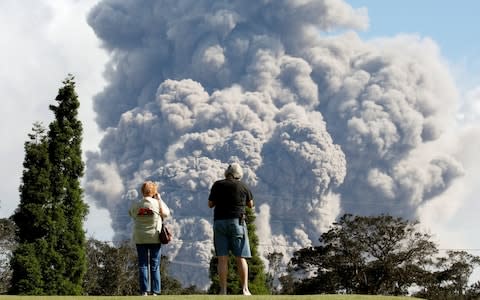Man struck by flying lava amid warning Hawaii volcano eruption could cover island in noxious plume

A man injured by flying lava as he sat on his third floor balcony has become the first casualty of the eruption of Hawaii's Kilauea volcano .
The unnamed man is in a serious condition after his leg was smashed by the volcanic debris, which can hit temperatures of over 1000 degrees Celsius at the point of eruption, in the town of Pahoa on Saturday.
"It hit him on the shin and shattered everything there down on his leg," said Janet Snyder, a spokesperson for the Office of the Mayor, County of Hawaii.
Hawaii damage
She added that lava spatters “can weigh as much as a refrigerator and even small pieces of spatter can kill."
The incident came as lava streams threatened to cut off evacuation routes and authorities warned a noxious plume could cover the island as lava began to reach the sea.
"Laze" - clouds of hydrochloric acid and steam laced with fine glass particles - forms when hot lava hits sea water. Molten rock has been observed flowing in the Pacific ocean in recent days.
"Even the wispy edges of it can cause skin and eye irritation and breathing difficulties," a spokesman for the US Geological Survey warned.

Almost fifty properties have so far been wiped out by flowing lava since Kilauea began to erupt on May 3. Four more were destroyed over the weekend.
A handful of people were trapped when a flow severed a road Friday. Some had to be airlifted to safety.
Wil Okabe of the Hawaii's mayor's office said of the evacuees: "They shouldn't be in that area."
Kilauea volcano - Hawaii - locator map
Kilauea has created nearly two dozen lava-shooting fissures on Hawaii's Big Island since the eruption began, spewing lava and emitting toxic gases.
Thousands have been forced to evacuate their homes and experts remain unsure of where more of the hazardous cracks might open up, or when the volcanic activity might stop.
"We have no way of knowing whether this is really the beginning or toward the end of this eruption," said Tom Shea, a volcanologist at the University of Hawaii. "We're kind of all right now in this world of uncertainty."

